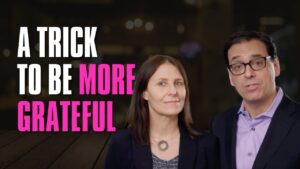LINKS AND FURTHER READING:
- The paper I refer to in this video is “Self-Talk as Regulatory Mechanism: How You Do It Matters,” which appeared in the Journal of Personality and Social Psychology.
- If you enjoyed this Pinkcast, you might also enjoy Pinkcast 1.9 about interrogative self-talk.



Hi. Please add captions or transcription so I can follow your videos.
Thank you
Deaf Reader
We had a glitch. For some reason, the transcription delayed so it wasn’t included in the video. It should be up within a few hours. Sorry.
Another great insight Dan, how do you think this would work if combined with interogatory self talk (which I use after learning about it from you): would this have a compound effect? Eg Bob might ask, Can you (Bob) fix it?
I’ve gleaned so much from your work over the years, thank you Dan
Ren
Self distancing is an excellent for all of us. For any problem we have we can ask ourselves what we would we tell our best friends who have the same problem. It is amazing what happens when we reframe a problem or situation this way. If only we could apply the wisdom we know when others have problems to ourselves it would make our lives much easier.
I feel the same way about solving other people’s problems. It seems more natural to listen, assess and suggest solutions to someone else’s issue. As you say it’s just a clever extension of that effect.
I think intuitively we prepare better for every situation by asking ourselves key questions. Ian what are you trying to get out of this meeting? I’m sure the research on self-visualization in sport taps into the same third person effect.
Great Stuff as always. Very useful and Jane thanks you!
You made me laugh out loud! I really enjoy you, Dan Pink! I am definitely going to try this!
Someone once told me to watch out for the “itty bitty shitty committee” that was sitting on my shoulder and talking to me in my ear – and that is where I thought you were going to go when I read the heading for this Pinkcast on self talk – because negative self talk can be so damaging.
But, instead – it was quite instructional in a different way.
Btw – I have been preaching Motivation 2.0 from Drive to everyone that will listen (ha!) and just became a free agent and read Free Agent Nation… It is so good. It is amazing how much of what is in that book is still timely 17 years later!!! Sorry about the ramble on a different topic!
Hope everyone has a great day. I am going to tell myself to get back to work… wait for it…
“Sharla, you will make more money if you focus on your work. Time to get back to it.” 🙂
Joel thanks you Dan.
Daniel
I have a training program for teens to help them build personal LifePlans. http://www.lifeplan.org. In the program we teach a module on Self Talk and its always one of the favorites of the kids.
I’ll download the paper for my colleagues.
Last thought, I always think of Seinfeld when the 3rd person idea is raised. https://youtu.be/xoskJPDbXR0
So much of life eventually comes down to a Seinfeld episode! I was thinking the same thing!
Thanks Dan! Another great pink cast! This is something similar to what I frequently use with clients – perspective taking. Looking at what you’re doing from another perspective – either yourself from a distance or from the perspective of another person. I love how you’ve explained this- simple, clear, straightforward.
Dan,
Your self-talk advice is on the mark. Thanks for another good Pinkcast As you said, just shifting to 3rd person, “You can do this” somehow works.
Yet, on the movie front, I will have to DISAGREE about “Three Identical Strangers.” I would NOT recommend it. I saw it yesterday and though it is a sad, true documentary, it’s a clear pass for me for 3 big reasons:
1. DEPRESSING. Though of course, I feel very sad for the triplets who were unfairly treated like “Lab Rats” by the cold adoption agency pf the 1950s it is frankly, a bummer of a movie.
2. CAST POORLY: The film is not artfully cast. I grew up knowing twins and triplets very well in my smaller town. Speaking as a frequent moviegoer and a former documentary filmmaker, there were far more engaging subjects to pick.
3. AMATEUR: Movie was nor engagingly shot or edited.As my twin friend said, “Do we need 2 hours looking close-up at one guy’s pores?” Its Plain Jane documentary style is pedestrian. Compare it with the documentary genius of say, a Michael Moore and it is humorless, drab and clunky.
Just my two cents. There is room for all views.
Great stuff. Thanks
George Constanza was on to something all those years ago!
Hoo thanks Dan.
Hoo’s going to be more effective talking to himself.
Thanks, Dan! I’ll be giving it a shot. (This reminds me of Seinfeld’s “The Jimmy” episode, by the way.)
You’ve done it again, Dan! You’ve shared life-changing wisdom in 2 mins. I like the idea of using third person, but honestly I’m not a fan of using second person within my self-talk. I invite you to contemplate the following reason, based on the wisdom I’ve gained from others in your field, and let me know what you think.
I always try to use “I” when sharing my thoughts, opinions and advice with others so that I maintain proper boundaries. (So, naturally, I use first person when speaking to myself.) It seems these “I” messages are better received when presented to others this way: “I think doing that would be wise” vs “You should do it; it’s the wise thing to do.” H. Stephen Glenn called the latter Directing, a Barrier to communication and relationships. So, using second person when talking to myself doesn’t feel good to me; it’s not self-motivating. However, I think I can live with the third person version, which feels more like an all-knowing and wise higher power speaking to me. ?
On another topic, I prefer your old filming style -closer up with your bookcase behind you. I felt like your friend, chatting with you in your office. Now, with you in a suit coat, further away against a gray background, I feel like you are not my friend but a prefessor, lecturing at me in a large lecture hall.
Now, I’d be curious to know how well my opinion about your filming style would be received if I had said it in second person:
Your old filming style -closer up with your bookcase behind you was better. It felt like you were a friend, chatting with me in your office. Now, with you in a suit coat, further away against a gray background, you are not my friend but a prefessor, lecturing at me in a large lecture hall.
Any change in the way it would be received? I bet the ‘first person’ version was better received, because it carried with it a positive energy, inviting connection. The ‘second person’ version, while it shared the same content, provided a sting, promoting withdrawal.
Interesting. I’m still taking it in and will definitely be trying this on my next run.
It feels like this may come more naturally for some activities (I do feel like for things that are physical, I default to 2nd or 3rd person), but not so much for other things (things of an emotional nature or perhaps where self-guilt/blame is involved).
Perhaps the article you cite goes into this.
Thanks for another great post!
As a 25-year coach, I am a big believer in self talk. I have seen people totally turn around their career and business trajectories by being really clear and deliberate with how they talk to themselves.
I love your research and tweaks on this subject — you always give us the edge. 🙂
Tom thanks you. As a runner, I have often listened to my self talk during difficult runs. Your suggestion of using the third person, makes sense to me, as it is as if my coach were talking to me. Once again, I thank you for the wisdom you share.
Tom
Hello,
A real insight in your Pinkcast also related to teaching educators the difference between concrete and abstract self-talk! When your self-talk is in the first person, it is a statement of one’s own perceptions and feelings. When you speak from the second person or third person pronoun, the information appears to be an abstraction of one’s own perceptions and feelings. Abstraction skills in the brain is evidenced when you are able to see yourself outside yourself. Many younger children aren’t there yet, but when abstract thinking develops, it means a person can generate the second and third person pronouns about one’s own perceptions. When I was a junior high vice principal, I had to adjust the discussions of what went wrong when a student was sent to the office, based on the differences between seventh and ninth grade students. Seventh graders were not usually able to tell you how others, including the teacher or classmates, felt about the behavior of the student. By ninth grade, the student could tell me how a teacher might have felt about the behavior. It meant different dispositions would be appropriate.
Scott thanks you for this very helpful tip.
Now I understand Elmo!!!!
This makes sense to me. I encourage kids to do self-talk in the classroom when they’re working out of their comfort zone. I think shifting from the first person to second or third person, and creating a certain distance from the “I”, may help keep things in perspective and may help keep self-sabotage out of the mix. Make sense?
Love this Dan! While on a recent vertical climb, i kept telling myself, “you can do this Laura!. You are the little engine that could!” and when I watched your video I laughed out loud. Thanks for making me smile.